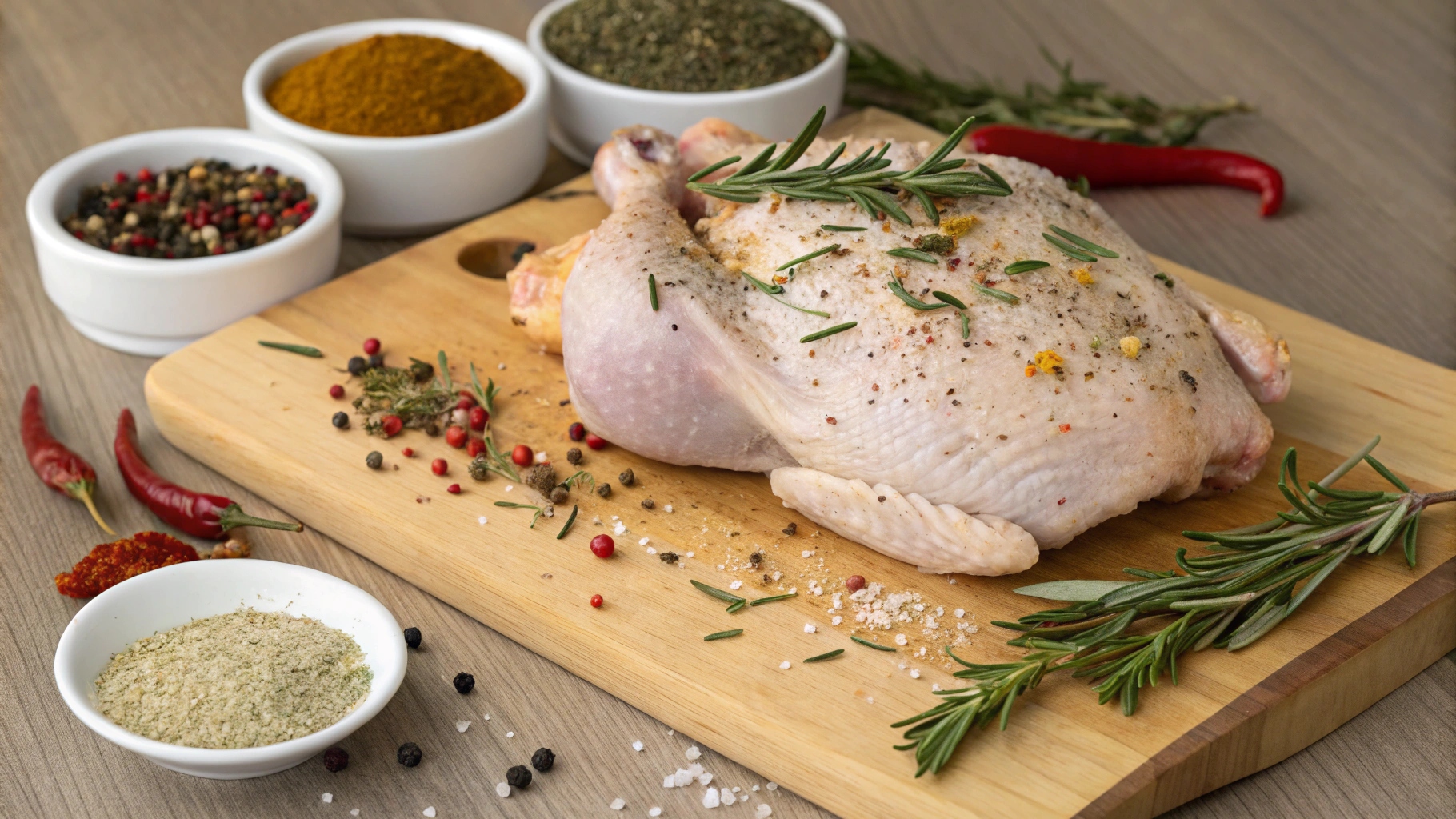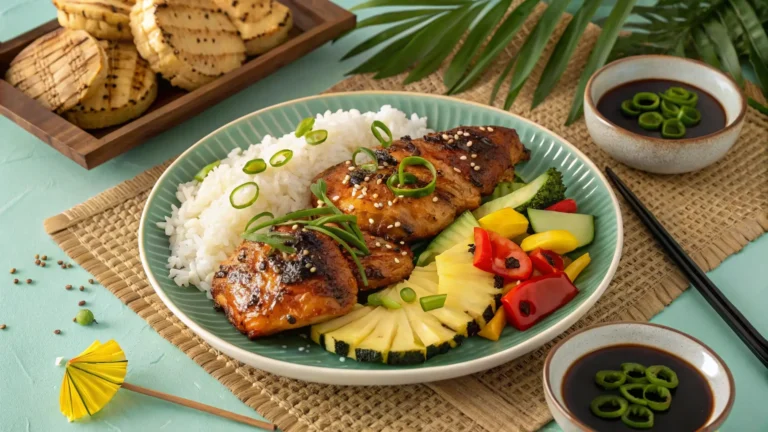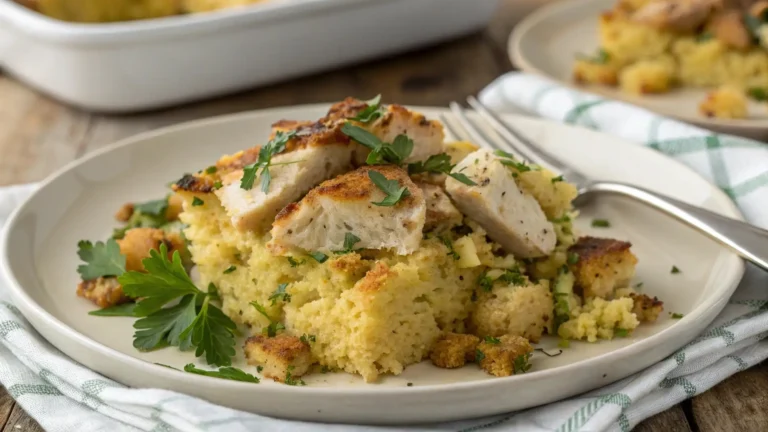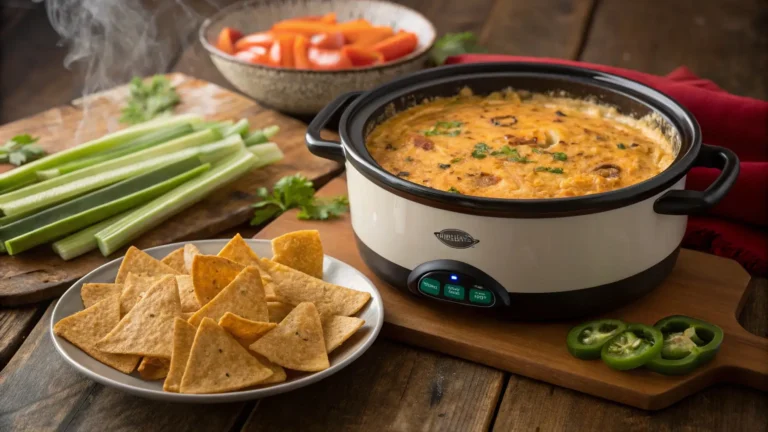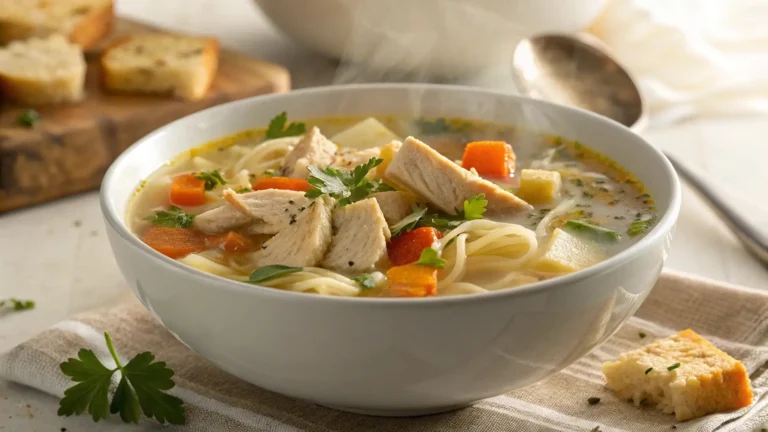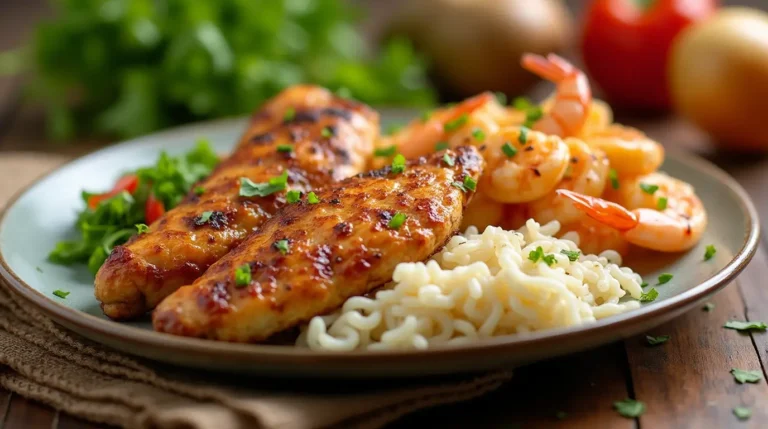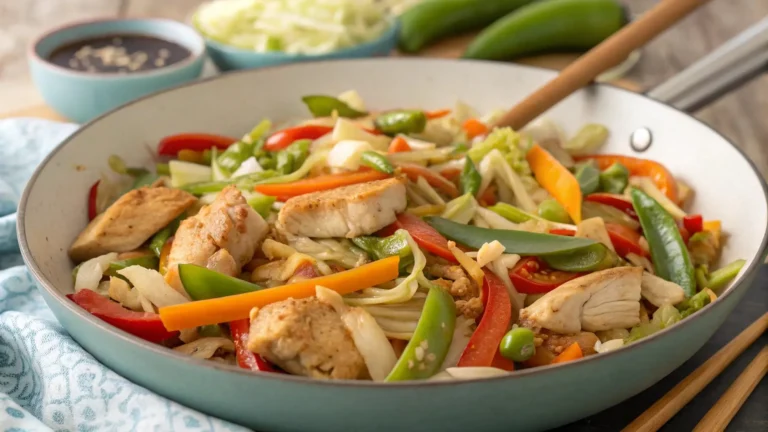The Best Chicken Seasoning Recipe
Ingredients
Before mixing your seasoning, gather these essential spices and herbs to create a well-balanced flavor profile.
Must-Have Pantry Seasonings
For a classic chicken seasoning blend, you need:
- Paprika – Adds a mild sweetness and a rich, warm color
- Garlic Powder – Enhances savory depth and aroma
- Onion Powder – Complements the garlic with a subtle sweetness
- Black Pepper – Adds a touch of sharp heat
- Salt – Enhances overall flavor and brings out natural juices
- Dried Oregano – Provides an earthy, slightly bitter balance
- Dried Thyme – Adds a fragrant, herbal note
- Cayenne Pepper (Optional) – Boosts the heat for spice lovers
✅ Pro Tip: Using smoked paprika instead of regular paprika can add a smoky depth to your seasoning blend.
Optional Add-Ins
Want to elevate your homemade chicken seasoning? Try these additions:
- Brown Sugar – Adds a hint of sweetness and helps with caramelization
- Lemon Zest – Brightens up the flavor profile
- Cumin – Provides a smoky, slightly nutty taste
- Chili Powder – Enhances spiciness with a bold kick
- Ground Mustard – Adds a tangy undertone

Equipment Needed
To make and store your chicken seasoning, you’ll need:
✔ Measuring spoons – For accurate spice measurements
✔ Mixing bowl – To combine ingredients evenly
✔ Airtight spice jar – For proper storage and freshness
✔ Spice grinder (optional) – If using whole spices for a fresher blend
✅ Pro Tip: Grind whole spices like black pepper and cumin just before mixing for a more aromatic and flavorful seasoning blend.
Instructions
How to Season Chicken Breast (Step-by-Step)
Follow these easy steps to season chicken breast like a pro:
1️⃣ Pat the chicken dry with paper towels—this helps the seasoning stick better.
2️⃣ Drizzle a small amount of olive oil over the chicken breast to help the seasoning adhere.
3️⃣ Sprinkle the seasoning blend evenly on both sides. Use your hands to press it in for better absorption.
4️⃣ Let the chicken sit for 10-15 minutes before cooking—this allows the flavors to penetrate.
✅ Pro Tip: For an even deeper flavor, season the chicken and refrigerate it for at least 30 minutes before cooking.
How to Cook Seasoned Chicken Breast
Cooking seasoned chicken breast correctly ensures juicy, flavorful results. Here’s how:
✔ Grilling: Cook over medium-high heat for 6-7 minutes per side until the internal temperature reaches 165°F (75°C).
✔ Pan-Searing: Heat a skillet over medium-high heat, add a little oil, and cook for 5-6 minutes per side.
✔ Baking: Preheat oven to 400°F (200°C) and bake for 20-25 minutes.
✔ Air Frying: Cook at 375°F (190°C) for 15 minutes, flipping halfway through.
✅ Pro Tip: Let cooked chicken rest for 5 minutes before slicing to retain juiciness.

Storage Instructions
How Long Does Chicken Seasoning Last?
Homemade chicken seasoning blends can last up to 6 months when stored properly. The potency of spices gradually fades over time, so for maximum freshness, make small batches every 3-4 months.
Tips for Preserving Freshness
- Store in an airtight glass jar to prevent moisture exposure.
- Keep away from direct sunlight and heat to avoid flavor loss.
- Label your seasoning jar with the date of preparation.
Nutrition Facts
Calories per Serving
A standard serving (1 teaspoon) of this seasoning blend contains approximately 5 calories.
Macronutrient Profile
✔ Carbs: ~1g (from dried herbs and spices)
✔ Fats: 0g
✔ Protein: 0.2g
✔ Sodium: Varies based on salt content
✅ Pro Tip: Adjust the salt content based on dietary needs—opt for low-sodium variations if necessary.
Notes & Pro Tips
Flavor Customizations
Want to tweak the flavor? Here are some ideas:
🔥 Spicy Variation: Add more cayenne pepper or crushed red pepper.
🍋 Zesty Variation: Add dried lemon zest for a citrusy punch.
🧄 Garlic Lover’s Blend: Double the garlic powder for extra savoriness.
Common Mistakes to Avoid
❌ Over-seasoning – Too much seasoning can overpower the natural chicken flavor.
❌ Skipping the resting time – Let seasoned chicken sit before cooking for better absorption.
❌ Using old spices – Spices lose potency over time, so check expiration dates.
Want more chicken seasoning ideas? Check out:
✔ Best Sauces to Pair with Chicken
✔ How to Cook Chicken Breast Like a Pro
What Do You Season Chicken With?
Seasoning is the key to transforming bland chicken into a flavorful masterpiece. The right blend of spices and herbs not only enhances taste but also complements different cooking methods like grilling, roasting, pan-frying, and air-frying.
This guide covers:
✅ Essential spices & herbs for the perfect chicken seasoning
✅ Regional flavor variations to match different cuisines
✅ Dietary-friendly seasoning options
Essential Spices & Herbs
A good chicken seasoning blend balances salty, sweet, smoky, and aromatic flavors. Here are the must-have spices and herbs for seasoning chicken:
🔹 Base Seasonings (Essential for Any Recipe)
✔ Salt – Enhances all other flavors (use kosher or sea salt for best results).
✔ Black Pepper – Adds a slight heat and depth of flavor.
✔ Garlic Powder – A must-have for rich, savory taste.
✔ Onion Powder – Complements garlic with a mild sweetness.
🌿 Herbal & Aromatic Additions
✔ Paprika – Sweet or smoked paprika adds warmth and color.
✔ Oregano – Brings a Mediterranean touch with earthy notes.
✔ Thyme – Pairs well with lemon, garlic, and grilled chicken.
✔ Rosemary – Strong, aromatic, and perfect for roasted chicken.
🔥 Spice It Up (Optional Enhancements)
✔ Cayenne Pepper – Adds a fiery kick for spice lovers.
✔ Chili Powder – Gives a mild smokiness.
✔ Cumin – Earthy and warm, commonly used in Tex-Mex recipes.
✔ Coriander – Bright, citrusy, and often used in Indian-style chicken.
✅ Pro Tip: For a deeper flavor, toast whole spices (like cumin and black pepper) in a dry pan before grinding them.

Regional Flavor Variations
Want to match your chicken seasoning to global flavors? Here are some popular regional seasoning blends:
Mediterranean-Style Chicken Seasoning
The Mediterranean blend is herbaceous and zesty, perfect for grilled chicken, gyros, or baked chicken breasts.
✅ Ingredients:
- 1 tbsp oregano
- 1 tbsp thyme
- 1 tsp garlic powder
- 1 tsp onion powder
- ½ tsp lemon zest
- ½ tsp black pepper
- ½ tsp sea salt
💡 Best Cooking Methods: Grilling, Roasting, Pan-searing
Smoky BBQ Chicken Seasoning
For bold, smoky, and slightly sweet chicken, use this BBQ-inspired blend. Perfect for grilled and oven-baked chicken.
✅ Ingredients:
- 1 tbsp smoked paprika
- 1 tbsp brown sugar
- 1 tsp garlic powder
- 1 tsp onion powder
- 1 tsp cumin
- ½ tsp cayenne pepper
- ½ tsp salt
- ½ tsp black pepper
💡 Best Cooking Methods: BBQ, Grilling, Air-frying

Dietary Adjustments
If you have dietary restrictions, you can easily modify chicken seasoning blends while keeping them flavorful.
Low-Sodium Options
Many store-bought seasonings contain excess salt. To make a low-sodium version:
🔹 Use fresh herbs instead of dried for enhanced natural flavor.
🔹 Add citrus zest (lemon, lime, or orange) to bring out natural chicken flavors.
🔹 Replace salt with spices like cumin, smoked paprika, and black pepper.
✅ Recommended Blend:
- 1 tbsp smoked paprika
- 1 tbsp garlic powder
- 1 tsp onion powder
- ½ tsp black pepper
- ½ tsp cumin
- ½ tsp lemon zest
Gluten-Free Mixes
Most individual spices are naturally gluten-free, but some pre-made seasonings contain gluten-based additives.
✅ To ensure a 100% gluten-free blend:
✔ Buy pure spices (check labels for cross-contamination).
✔ Avoid seasoning packets with anti-caking agents.
✔ Use fresh ground spices for better control.
✅ Gluten-Free Spicy Chicken Seasoning Recipe:
- 1 tbsp chili powder
- 1 tbsp paprika
- 1 tsp garlic powder
- 1 tsp onion powder
- ½ tsp cumin
- ½ tsp black pepper
✅ Pro Tip: Always check ingredient labels on store-bought spice blends to confirm they’re gluten-free.
How to Season Chicken Like a Pro
Mastering how to season chicken is the secret to transforming an ordinary dish into a mouthwatering masterpiece. Whether you’re grilling, roasting, air-frying, or pan-searing, the right seasoning technique ensures maximum flavor and juiciness.
In this guide, we’ll cover:
✅ Dry rub vs. wet marinade – Which method works best?
✅ Layering flavors – How to build depth and richness
✅ Even coating techniques – Ensuring every bite is packed with taste
Dry Rub vs. Wet Marinade
Before seasoning, decide whether to use a dry rub or a wet marinade. Both methods enhance flavor, but each has its advantages depending on the cooking method.
🔹 Dry Rub (Best for Crispier Texture)
A dry rub consists of spices, herbs, and sometimes sugar that coat the chicken without adding moisture.
✅ Best for: Grilling, roasting, air-frying
✅ Key Benefits:
✔ Creates a flavorful crust when seared
✔ Doesn’t add excess moisture (perfect for crispy skin)
✔ Easy to store and use
🔹 How to Apply a Dry Rub:
- Pat the chicken dry to remove excess moisture.
- Generously coat with oil or melted butter to help the rub stick.
- Massage the spice mix evenly onto the surface.
- Let it rest for 15–30 minutes before cooking for deeper penetration.
🔹 Wet Marinade (Best for Juicier Chicken)
A wet marinade is a mixture of spices, herbs, acids, and oil that infuses flavor deeper into the meat.
✅ Best for: Grilled, pan-seared, and baked chicken
✅ Key Benefits:
✔ Tenderizes the meat (thanks to acids like lemon juice or vinegar)
✔ Helps seasonings penetrate deeper
✔ Prevents drying out during cooking
🔹 How to Marinate Chicken Properly:
- Mix spices, herbs, oil, and acid (like lemon juice or yogurt).
- Submerge the chicken in the marinade inside a sealed bag.
- Refrigerate for at least 30 minutes (or up to 12 hours for deep flavor).
- Pat dry before cooking to ensure proper searing.

Layering Flavors
The secret to restaurant-quality chicken is layering flavors. Instead of just one seasoning mix, use base seasonings first and finish with flavor boosters after cooking.
Base Seasonings (Essential for Depth of Flavor)
The foundation of any great chicken seasoning includes:
✔ Salt & Black Pepper – Enhances all other flavors.
✔ Garlic & Onion Powder – Adds richness and umami.
✔ Paprika – Provides color and mild smokiness.
Pro Tip: If using a wet marinade, add an acid (lemon juice, vinegar, or yogurt) to tenderize the meat.
Finishing Touches (To Boost Flavor After Cooking)
After cooking, add final flavor touches to make your chicken taste even better:
✅ Fresh Herbs – Chopped parsley, cilantro, or basil add brightness.
✅ Citrus Zest – A squeeze of lemon or lime enhances grilled chicken.
✅ Compound Butter – A mix of butter, garlic, and herbs melted over hot chicken.
🔥 Want extra crunch? Sprinkle flaky sea salt and cracked black pepper right before serving!

Techniques for Even Coating
No one wants unevenly seasoned chicken where some bites are too salty while others lack flavor. These techniques ensure perfect seasoning coverage.
Massage Method (For Dry Rubs & Marinades)
Best for: Bone-in chicken, whole chicken, and large cuts
✅ Steps:
- Use clean hands to rub seasoning into every part of the chicken.
- Lift the skin slightly to season underneath for deeper flavor.
- Let it rest for 15 minutes to allow absorption.
🔹 Why it Works: Rubbing helps the seasonings stick better and ensures even distribution.
Shaker Jar Hacks (For Quick & Even Coating)
Best for: Chicken wings, drumsticks, cubed chicken
✅ Steps:
- Add the seasoning blend to a shaker jar or spice bottle.
- Place chicken in a large ziplock bag or bowl.
- Shake the seasoning over the chicken, tossing as you go.
- Coat all sides evenly without making a mess.
🔹 Why it Works: Using a shaker jar distributes seasoning evenly in seconds!

Storing Chicken Seasoning
Proper storage of chicken seasoning ensures its freshness, potency, and flavor for longer periods. Whether you make a homemade seasoning blend or store a pre-packaged mix, the right techniques can help maintain its aroma and taste.
In this guide, we’ll cover:
✅ Best storage methods for homemade and store-bought seasonings
✅ Shelf-life guidelines to prevent spice expiration
✅ Airtight storage & freezing tricks to lock in flavor
Pantry Storage
For maximum shelf life, store chicken seasoning in a cool, dark, and dry place. A pantry or spice cabinet away from heat and moisture is ideal.
Airtight Containers (Best for Long-Term Freshness)
Why Use Airtight Containers?
✔ Prevents moisture absorption (no clumps or spoilage)
✔ Keeps spices fresh longer by blocking air exposure
✔ Protects against odors from other pantry items
🔹 Best Containers for Storing Chicken Seasoning:
✅ Glass spice jars with tight lids (prevents air leaks)
✅ Mason jars with sealed tops (ideal for larger batches)
✅ Metal tins (protect from sunlight)
Pro Tip: Avoid plastic containers unless they are BPA-free and airtight, as plastic can absorb strong spice odors over time.

Shelf Life Guide (How Long Does Chicken Seasoning Last?)
✅ Homemade spice blends: 6-12 months
✅ Store-bought chicken seasoning: Up to 2 years (check the expiration date)
✅ Whole spices (e.g., peppercorns, cumin seeds): 2-3 years (last longer than ground spices)
🔹 How to Tell If Seasoning Has Expired:
✔ Loss of aroma – Rub a pinch between your fingers. If it smells weak, it’s time to replace.
✔ Dull color – Spices should be vibrant, not faded.
✔ Clumping – Moisture exposure causes spices to clump, making them less effective.
Pro Tip: Always label homemade spice blends with the date of preparation to track freshness.
Freezing Homemade Blends
Freezing is a less common but highly effective way to store homemade seasoning blends, especially if you make them in large batches.
Ice Cube Tray Trick (Freezing for Easy Use)
✔ Perfect for meal prep: Freeze small portions for easy access.
✔ Locks in freshness: Prevents spice oxidation and loss of flavor.
✔ Best for marinades & wet rubs: Works great if you mix seasoning with oil or butter.
🔹 How to Freeze Chicken Seasoning Using Ice Cube Trays:
1️⃣ Mix your seasoning blend with a little oil or melted butter.
2️⃣ Pour the mixture into an ice cube tray (silicone trays work best).
3️⃣ Freeze for 2-3 hours until solid.
4️⃣ Transfer the frozen seasoning cubes to a ziplock bag for long-term storage.
5️⃣ When ready to use, pop out a cube and let it melt into the pan while cooking!

Chicken Seasoning Pairings: The Ultimate Flavor Guide
Pairing the right chicken seasoning with proteins, side dishes, and sauces enhances every meal. Whether you’re grilling, baking, or roasting, matching flavors properly makes all the difference.
In this guide, we’ll cover:
✅ Best chicken cuts for seasoning
✅ Side dishes & sauces that complement the flavors
✅ How to create balanced meals with chicken seasoning
Perfect Protein Matches
Different cuts of chicken absorb seasoning differently based on their fat content and cooking method. Here’s how to pair your seasoning blend with grilled, baked, or pan-seared chicken.
Grilled Chicken (Bold & Smoky Pairings)
🔥 Best Seasoning Blends:
✔ Smoky BBQ rub (paprika, brown sugar, garlic, chili powder)
✔ Lemon-herb seasoning (oregano, thyme, lemon zest, garlic)
✔ Spicy Cajun mix (cayenne, black pepper, onion powder, smoked paprika)
💡 Pro Tip: Let the chicken marinate for at least 30 minutes before grilling to infuse flavor.

Baked Chicken Thighs (Rich & Juicy Flavor Boosters)
🍗 Best Seasoning Blends:
✔ Garlic butter rub (butter, garlic powder, parsley, black pepper)
✔ Honey mustard spice blend (mustard powder, honey, paprika, salt)
✔ Mediterranean-style mix (cumin, coriander, lemon zest, rosemary)
💡 Pro Tip: Bake at 400°F (200°C) for 35-40 minutes for crispy skin and tender meat.
Side Dishes & Sauces
Pairing chicken seasoning with the right sauces and side dishes makes a meal more flavorful and balanced.
Stir-Fry Sauce Recipes (Asian-Inspired Pairings)
🥡 Best Chicken Seasoning Pairings:
✔ Ginger-soy sauce (for an umami kick)
✔ Honey garlic glaze (for sweet-savory balance)
✔ Spicy sesame sauce (for heat and depth)
💡 Pro Tip: Toss seasoned chicken with a sauce after cooking to keep the flavor locked in.
Balsamic Vinaigrette Pairing (Light & Zesty Match)
🍷 Best Chicken Seasoning Pairings:
✔ Italian herb seasoning (basil, oregano, thyme, garlic)
✔ Lemon-pepper rub (zesty & bold)
✔ Dijon mustard-spiced chicken
💡 Pro Tip: Drizzle balsamic vinaigrette over grilled chicken or use it as a marinade before cooking.
Frequently Asked Questions (FAQ) About Chicken Seasoning
1. What is the best seasoning for chicken?
The best seasoning depends on the flavor profile you’re looking for. For a smoky BBQ flavor, try a blend of paprika, garlic powder, brown sugar, and chili powder. If you prefer herbal flavors, go for a lemon and thyme seasoning. For a spicy kick, a Cajun blend with cayenne pepper and black pepper works great.
2. How do I season chicken for grilling?
When seasoning chicken for grilling, use bold and smoky seasonings like BBQ rubs, garlic-lemon, or Cajun seasoning. Make sure to coat the chicken generously with the seasoning and let it marinate for at least 30 minutes to enhance flavor. Grilling over medium-high heat ensures crispy skin and juicy meat.
3. How long should I let chicken marinate in seasoning?
For maximum flavor, marinate the chicken for at least 30 minutes to 1 hour. For deeper flavor, let it marinate overnight in the fridge. Just be cautious not to marinate for too long (more than 24 hours) as some seasonings might overpower the natural flavor of the chicken.
4. Can I make my own chicken seasoning blend?
Absolutely! Homemade chicken seasoning is easy to make and customizable. Start with a base of salt, pepper, garlic powder, and onion powder, then experiment by adding paprika, cumin, or dried herbs like oregano and thyme for extra flavor.
5. Should I use dry rub or wet marinade for seasoning chicken?
Both options work well, but they offer different textures and flavors.
- Dry rubs create a crispy, flavorful crust on the outside of the chicken.
- Wet marinades infuse the chicken with moisture and flavor, making the meat juicy and tender.
Choose based on the cooking method (grilling, baking, or pan-frying) and the type of texture you’re aiming for.
6. How do I store homemade chicken seasoning?
To keep your homemade seasoning fresh, store it in an airtight container in a cool, dark place. Proper storage will keep your seasoning fresh for up to 6 months. For longer storage, you can even freeze your homemade seasoning in an ice cube tray to keep it fresh for up to a year.
7. Can I use chicken seasoning for other meats?
Yes! Chicken seasoning blends can be used for other meats like pork, beef, and lamb. You can adjust the seasoning depending on the meat and flavor profile you prefer. For example, BBQ rubs are great for pork ribs, while Mediterranean herbs can complement lamb chops.
8. How do I know when my chicken is seasoned enough?
A well-seasoned chicken should have a noticeable layer of flavor on the surface. If you’re using a dry rub, you should see a thin coat of seasoning covering the meat. For marinades, the chicken should be moist and have absorbed the flavors. Always taste a small piece of the chicken after cooking to check the balance of seasonings.
9. Can I use pre-made chicken seasoning blends?
Yes, store-bought chicken seasoning blends can save time and provide a quick solution. However, make sure to read the ingredient list to avoid unwanted additives or too much salt. Opt for a seasoning blend with natural ingredients and adjust the quantities as needed to suit your taste.
10. Can I season chicken in advance?
Yes, seasoning chicken in advance is a great way to deepen the flavor. Marinate the chicken for several hours or overnight for maximum flavor infusion. For dry rubs, you can season the chicken a few hours ahead and refrigerate it until you’re ready to cook.

